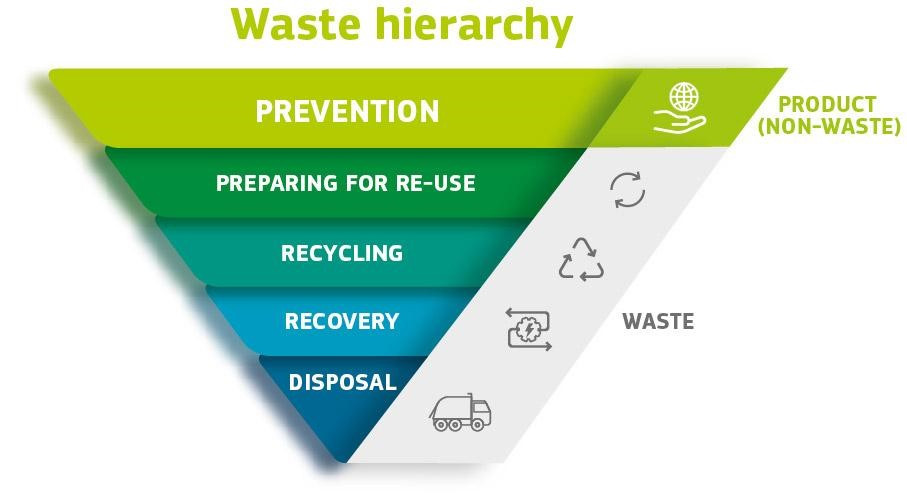Waste to Energy – Controversial power generation by incineration
How waste-to-energy incineration works
Waste-to-energy plants use household garbage as a fuel for generating power, much like other power stations use coal, oil or natural gas. The burning of the waste heats water and the steam drives a turbine to generate electricity. A more indepth explanation of the process can be found here.
Waste material is received in an enclosed receiving area, where it is thoroughly mixed in preparation for combustion.
Mixed waste enters the combustion chamber on a timed moving grate, which turns it over repeatedly to keep it exposed and burning.
Fine airborne particulates (fly ash) are removed in the filter baghouse. The acidic combustion gasses are neutralised with an injection of lime or sodium hydroxide.
The unburned remains of combustion —"bottom ash"— are passed by magnets and eddy current separators to remove both ferrous (steel and iron) and other metals, such as copper, brass, nickel, and aluminum, for recycling. The remaining ash can be used as aggregate for roadbeds and rail embankments.
Superheated steam powers the steam turbine generator. The cooling steam is cycled back into water through the condensor or diverted as a heat source for buildings or industry. Cooled stream is reheated in the economiser and superheater to complete the steam cycle.
Activated carbon (charcoal treated with oxygen to increase its porosity) is injected into the hot gases to absorb and remove heavy metals, such as mercury and cadmium. Nitrogen oxide in the rising burn gases is neutralised by the injection of ammonia or urea. Dioxins and furans are destroyed by exposing flue gases to very high temperatures..
Energy generation from waste in the EU and Germany
In 2018 in the EU, overall energy production from all waste (industrial waste, renewable and non-renewable municipal solid waste (MSW), non-renewable waste) amounted to about 2.4% of the total energy supply.
MSW, also called household waste, accounts for only about 10% of total waste generated. This is waste collected by municipal authorities and disposed of through waste management systems. MSW is mainly generated by households, although it also includes similar waste from offices, shops, and public administrations. The average European is responsible for 500 kg of MSW a year.
Changes in waste management legislation, such as the phasing out of landfilling, has caused WtE incineration to grow dramatically: in the EU, the quantity of MSW incinerated rose from 32 million tonnes (67 kg per capita) in 1995 to 70 million tonnes (136 kg per capita) in 2018. One cause for this upshot: landfill dumping declined by 56%.
In the EU (2018), energy generation from waste is the highest in Germany (7.1 MWh), followed by the UK (4.4 MWh), France (2.5 MWh), Italy (2.4 MWh) and the Netherlands (2.2 MWh). WtE accounts for 4.3% of Germany’s primary energy use, according to German Environment Agency (UBA), the country's central environmental authority.
18 million European citizens receive electricity and 15 million receive heating from WtE plants.
WtE plants in Germany
There are currently about 100 waste incineration plants in Germany with a work force of 6,000 and total annual capacity of about 20 million tons. The largest plant in Germany with a capacity of 780,000 tons is the residual waste incineration plant in Cologne; the smallest is in Ludwigslust: capacity 50,000 tonnes.
In Germany, neither ITAD, the lobby of German incineration companies, nor UBA refers to WtE facilities as such but rather as Abfallverbrennungsanlage or thermische Abfallbehandlung, namely waste incineration plants or thermal waste treatment. They see the technology as primarily important for purposes of waste management and not energy production.
EU circular economy plans could make usable waste rare
There is currently a flurry of activity in the EU around the circular economy. The continent's ambitious recycling plans mean that most power production from waste could eventually run out of fuel and become obsolete.
The Waste Framework Directive, responsible for the “waste hierarchy”, requires that, as of 2020, EU households must recycle or prepare for re-use 50% by weight of waste materials, such as paper, metal, plastic and glass. And by 2025, the recycling and preparing for re-use of municipal waste shall be increased to a minimum of 55%, 60% and 65% by weight by 2025, 2030, and 2035 respectively.
The European Commission’s new Circular Economy Action Plan (CEAP) aims to halve residual waste by 2030. The European Parliament’s report on CEAP calls for minimising waste incineration and calls on the Commission to define an EU-wide approach for the management of non-recyclable residual municipal waste that ensures its optimal treatment. It warns about building an overcapacity of waste incineration that could hamper the development of the circular economy.
The Single Use Plastics Directive will, among other things, require that plastic-using companies include 25% of recycled PET (a clear, lightweight plastic that is widely used for packaging foods and beverages) in new PET bottles. This requirement, which is already fulfilled in some countries such as Germany and Denmark, will make recycled PET much more valuable and thus dramatically boost its percentage of recovery. It means that WtE plants will receive much less plastic which, in light of its composition – 99% of plastic is made from chemicals sourced from fossil fuels – has a combustion gradient nearly as high as fossil fuels.



